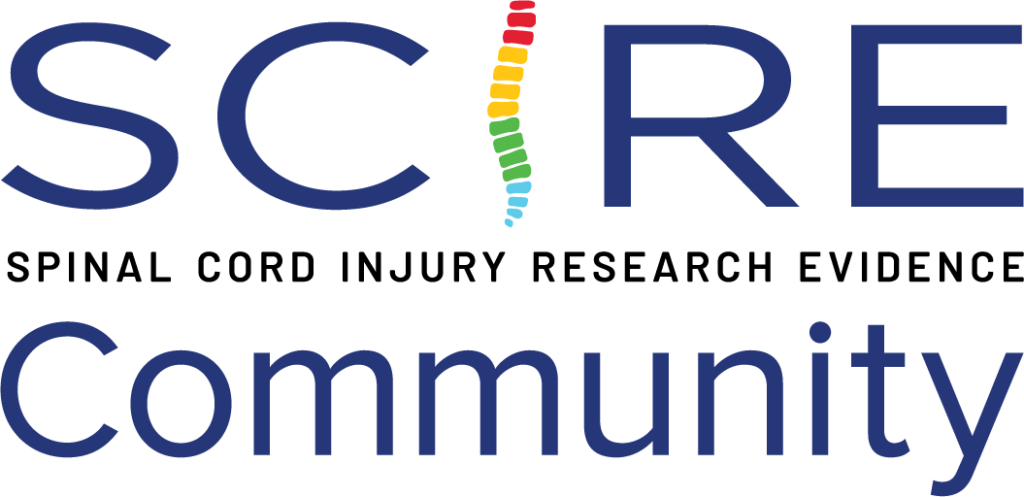Author: Dominik Zbogar | Reviewer: Kathleen Martin Ginis | Published: 25 March 2019 | Updated: 30 June 2023
Physical activity is an important consideration after spinal cord injury (SCI) and is a key factor in preventing lifestyle diseases. This page provides guidelines for physical activity following SCI.
Key Points
- People with SCI face tremendous physical, psychosocial, and environmental barriers to physical activity. They are less active and physically deconditioned than the general population and people with other disabilities.
- Overwhelming evidence suggests that people living with SCI can achieve health benefits from activity levels well below the generally recommended 150 min/week threshold.
- The guidelines herein were created for adults aged 18-64 with chronic SCI (at least one year post-onset), with consideration given to the potential risks of SCI-specific adverse events including upper-body over-use injuries, skin breakdown, autonomic dysreflexia, and over-heating as well as consideration to the feasibility of these guidelines in the SCI population.
 A group led by Dr. Kathleen Martin Ginis at the University of British Columbia and Dr. Victoria Goosey-Tolfrey at Loughborough University, UK developed international guidelines on exercise after SCI. The process of developing these guidelines involved a systematic review of relevant literature, consensus meetings, stakeholder feedback, and a formal audit of the process.
A group led by Dr. Kathleen Martin Ginis at the University of British Columbia and Dr. Victoria Goosey-Tolfrey at Loughborough University, UK developed international guidelines on exercise after SCI. The process of developing these guidelines involved a systematic review of relevant literature, consensus meetings, stakeholder feedback, and a formal audit of the process.
The result was the publication of the journal article about the guidelines (available in the journal Spinal Cord via nature.com/articles/s41393-017-0017-3) and the actual guidelines titled, “Scientific Exercise Guidelines for Adults with Spinal Cord Injury” which are described next.

For cardiorespiratory fitness and muscle strength benefits, adults with SCI should engage in:
- At least 20 minutes of moderate to vigorous intensity aerobic exercise 2 times per week.
- 3 sets of strength exercises for each major functioning muscle group, at a moderate to vigorous intensity, 2 times per week.
For cardiometabolic health benefits, adults with SCI are suggested to engage in:
- At least 30 minutes of moderate to vigorous intensity aerobic exercise 3 times per week.

Cardiometabolic health
Cardiometabolic health encompasses measures of body composition (e.g., fat mass, lean body mass) and risk factors for cardiovascular disease (e.g., high cholesterol and hypertension). Common measures to assess cardiometabolic health include a blood test to assess triglycerides and cholesterol, measuring blood pressure, and measuring height, weight, and waist circumference.
Cardiovascular fitness
Cardiovascular fitness refers to the ability of the heart and lungs to deliver oxygen to working muscles and can be assessed through a maximal graded exercise test which provides information such as peak oxygen uptake and peak power output.
Muscle strength
Muscle strength refers to the amount of force that a muscle can exert. It can be measured by lifting objects of specified weight or exerting force against a measurement tool such as a hand grip dynanometer.
These exercise guidelines provide minimum thresholds for improving cardiorespiratory fitness and muscle strength and for improving cardiometabolic health.
 If you are not already exercising, it is okay to start with smaller amounts of exercise and gradually increase duration, frequency, and intensity, as a progression toward meeting the guidelines. Doing exercise below the recommended levels may or may not bring small changes in fitness or cardiometabolic health.
If you are not already exercising, it is okay to start with smaller amounts of exercise and gradually increase duration, frequency, and intensity, as a progression toward meeting the guidelines. Doing exercise below the recommended levels may or may not bring small changes in fitness or cardiometabolic health.
 Exceeding these exercise guidelines would be expected to yield additional cardiorespiratory fitness and muscle strength and cardiometabolic health benefits. However, there are insufficient data to comment on the risks associated with a person with SCI exceeding these guidelines.
Exceeding these exercise guidelines would be expected to yield additional cardiorespiratory fitness and muscle strength and cardiometabolic health benefits. However, there are insufficient data to comment on the risks associated with a person with SCI exceeding these guidelines.
The guidelines should be achieved above and beyond the incidental physical activity one might accumulate in the course of daily living. Adults are encouraged to participate routinely in exercise modalities and contexts that are sustainable, enjoyable, safe and reasonably achievable.
Refer to our article on Physical Activity for more information!
These guidelines are appropriate for adults (aged 18-64) with chronic SCI (at least one year post-onset), neurological level of injury C3 and below, from traumatic or non-traumatic causes, including tetraplegia and paraplegia, irrespective of sex, race, ethnicity or socio-economic status.
The guidelines may be appropriate for individuals with a SCI less than one year post-onset, aged 65 years or older, or living with comorbid conditions. There is currently insufficient scientific evidence to draw firm conclusions about the risks and benefits of the guidelines for these individuals. These individuals should consult a health care provider prior to beginning an exercise programme.
The risks associated with these guidelines are minimal when managed in consultation with a health care professional who is knowledgeable in SCI. Individuals with a cervical or high thoracic injury should be aware of the signs and symptoms of autonomic dysreflexia during exercise.
Refer to our article on Autonomic Dysreflexia for more information!
These guidelines were developed using transparent and rigorous steps that align with international best-practices for developing clinical practice guidelines. They represent an important step toward developing exercise policies and programs for people with SCI around the world.
Hicks, A. L., Martin Ginis, K. A., Pelletier, C. A., Ditor, D. S., Foulon, B., & Wolfe, D. L. (2011). The effects of exercise training on physical capacity, strength, body composition and functional performance among adults with spinal cord injury: a systematic review. Spinal Cord, 49(11), 1103–1127.
Martin Ginis, K. A., van der Scheer, J. W., Latimer-Cheung, A. E., Barrow, A., Bourne, C., Carruthers, P., … Goosey-Tolfrey, V. L. (2018). Evidence-based scientific exercise guidelines for adults with spinal cord injury: an update and a new guideline. Spinal Cord, 56(4), 308–321.
Hoekstra, F., McBride, C.B., Borisoff, J. et al. (2020). Translating the international scientific spinal cord injury exercise guidelines into community and clinical practice guidelines: a Canadian evidence-informed resource. Spinal Cord. https://doi.org/10.1038/s41393-019-0410-1
Images credits
- Flag of the Netherlands: ©Zscout370, CC BY 4.0
- Flag of the United Kingdom: ©Xaosflux, CC BY 4.0
- Flag of France: Public Domain
- Flag of Germany: ©Anomie, CC BY 4.0
- Flag of Greece: Public Domain
- Flag of Indonesia: Public Domain
- Flag of Italy: ©Anomie, CC BY 4.0
- Flag of Japan: Public Domain
- Calligraphic rendition of Farsi: By Jahongard – Own work based on: Farsi.jpg, CC BY-SA 3.0
- Flag of South Korea: Public Domain
- Flag of Spain: ©Vzb83, CC BY 4.0
- Flag of Sweden: ©Mr. Stradivarius, CC BY 4.0
- Flag of Thailand: ©Zscout370, Public Domain
- Modified from: Journal article screencap©Kathleen A. Martin Ginis, CC BY-NC 4.0
- Modified from: The scientific exercise guidelines for adults with spinal cord injury©Kathleen A. Martin Ginis, CC BY-NC 4.0
- Modified from: Pictogram of person in wheelchair©Kathleen A. Martin Ginis, CC BY-NC 4.0
- Modified from: Speedometer: ©designvector, CC BY-NC 4.0
- Modified from: Speedometer: ©designvector, CC BY-NC 4.0





 Dutch
Dutch English
English German
German Indonesian
Indonesian Italian
Italian Korean
Korean Persian
Persian Spanish
Spanish Swedish
Swedish
